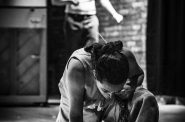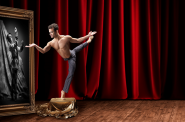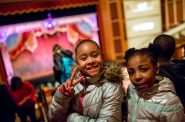Loewen’s intelligent design at the Pritzlaff
The sounds of trains — of steel on steel and blaring horns — mingled with the sound of Debra Loewen’s voice as her Wild Space Dancers took their places in the Pritzlaff Building Thursday night. Those sounds were previously recorded in and around old industrial building. Loewen had to shout through its vastness at rehearsals. And the train tracks are very near.
Ambient sound, amped up and framed to demand attention, taught us something about how to perceive this remarkable, sprawling piece, called In the Space Between. The whole thing is about amped-up ambience, awareness of time and space. Many times during the 90-minute piece, actual trains came by, and their real, live racket became part of the piece.
The 14 dancers — all women, and all magnificent in one way or another — took their places at the outset in front of three large screens. Random images — artworks, news photos, equations, landscapes, fashion photos, design drawings, celebrity shots, maps, many photos of trains, all manner of ads, geometric abstractions, street scenes current and vintage, and much more — popped up at random. Nothing connected the images but the curatorial eye of Tom Bamberger. Every image struck home, because Bamberger’s eye is extraordinary. I happen to know that the three projectors flashed 3,500 different images for a few seconds each. Bamberger programmed them to select randomly; still, I caught some repeating images as I passed by.
Which brings us to the second big idea of In the Space Between: The great human impulse to seek pattern, if not order, in everything around us. Repetition implies rhythm, and rhythm is pattern. The same goes with the way things line up. More than once, the image of a train popped up as an actual train screeched and rumbled a hundred yards away. It must mean something, right? Some design must be behind it, right? Maybe — but what do we mean, exactly, by design? Bamberger and Loewen make your brain fire faster than normal. Art should do that.
Real dance abounds in this piece. Duets occur all over the place — well-made dances, athletic, coherent and disciplined. Their formal quality derives from very tight ensemble in parallel dancing. Some little twist always attaches them to the environment. In the courtyard, for example, a garage door opened unexpectedly to provide dancers entrance and egress. A beautiful young blonde, languorous behind glass doors, suggested voyeurism. But then, she was close enough to make eye contact and made a point of holding it. (Are you looking at me?)
A trio at the east end of the east building played first on the bizarre shapes of shadows bent around an inside corner. Then the focus switched to architectural details. The dancers hopped up on window sills and let the windows frame them. In the end, they disappeared through an oddly small set of wooden double doors we’d barely noticed. A good deal of now-you-see-them, now-you-don’t magic happens, as Loewen takes full advantage of a very large space with many nooks, crannies, passageways and doors.
In the Space Between is a daring, site-specific modern dance, but it reminds me a little of Romantic white-act ballets. The women are like those traditional white-clad nymphs of old, but they inhabit an enchanted warehouse instead of an enchanted forest.
And like those old ballets, In the Space Between has its diva: Jade Jablonski. Clad in a red leotard and a voluminous red skirt with a sort of bustle, Jablonski gave a magnificent, surreal mad-scene solo in the west building. In the courtyard, she danced lyrically and sensually among the bricks. Then, coy and lovely as La Sylphide, Jade faded away down the long perspective of the covered alley.
In the Space Between can be disorienting, because you make your own path through it. But it makes more and more sense as you go along. At the start, in front of Bamberger’s screens, the dancers strike pose after pose, seemingly as random as the images behind them. As the evening goes on, we come to see those poses as the kernels of the duets. They recur and develop throughout the evening in a very satisfying way. That’s not random. That’s design.
In the Space Between will be repeated at 8 p.m. Friday and Saturday, Sept. 16 and 17. $25 for premium ticktes, $20 for general admission, $18 for students and seniors; visit Wild Space’s website. Enter the Pritzlaff Building on the Plankinton Avenue side, via the door with the 325 address.
Dance
-
New Riverwest Company, Production Impresses
 Feb 10th, 2020 by Brendan Fox
Feb 10th, 2020 by Brendan Fox
-
Milwaukee Ballet Show Remakes History
 Feb 10th, 2020 by Catherine Jozwik
Feb 10th, 2020 by Catherine Jozwik
-
Ballet Does Free Production of ‘Nutcracker’
 Dec 20th, 2019 by Richard Davis
Dec 20th, 2019 by Richard Davis























